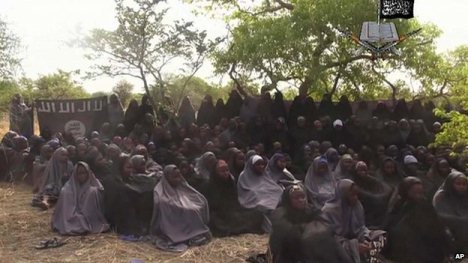The US has sent military, law-enforcement and development experts to Nigeria to help search for the missing girls who were kidnapped by Boko Haram militants from a secondary school in Chibok in remote northeastern Nigeria on April 14.
Some of the 276 Nigerian girls snatched from their school under cover of darkness appeared to re-emerge in a propaganda video shot by Boko Haram released on Monday.
The 27-minute video showed around 130 of the girls wearing grey and black veils. Two of them speak of their conversion from Christianity to Islam.
It also shows Boko Haram leader Abubakar Shekau offering to let the girls go if the Nigerian government releases his fighters from prison.
State department spokeswoman Jen Psaki told a news briefing on Monday: "We are providing intelligence, surveillance and reconnaissance support."
She said US teams on the ground "are digging in on the search and coordinating closely with the Nigerian government as well as international partners and allies".
Last week, US undersecretary for Africa Linda Thomas-Greenfield told Reuters in an interview that Nigeria had requested surveillance and intelligence from the United States.
Nigerian president Goodluck Jonathan has said he believes the girls are still in Nigeria. The leader of Boko Haram has offered to release them in exchange for members of its group being detained, according to a video posted on YouTube on Monday.
At 6pm on Monday, the last of 930,000 poll booths closed, the electronic voting machines were sealed and the Indian election, the biggest democratic exercise in human history, was finally over.
In five weeks of voting – phased to allow more than 8 million security personnel and officials to be redeployed around the country – 15,000 litres of indelible ink has been used to mark the fingers of 551 million people who have voted. From restive Srinagar to festive Goa, from the Bay of Bengal to the Rann of Kutch, the polls have been a lengthy collective journey taken by huge numbers of people, most still full of hope and expectation, but many increasingly anxious too.
None, however, doubt the fundamental importance of their right to choose between politicians.
"One vote can make you win, one vote can make you lose," said Sunil Kumar, a 50-year-old rickshaw puller in the northern holy city of Varanasi, who supports a family of 10 on earnings of about £2 a day.
On Monday officials said the election had seen record participation levels, shattering the previous record of 417 million set in India five years ago, according to the election commission. In some areas in earlier rounds about four-fifths of those eligible cast a ballot. Overall almost exactly two-thirds of eligible voters turned out.
More about:
















































